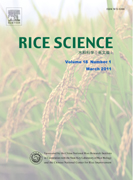|
|
QTL Analysis of Anoxic Tolerance at Seedling Stage in Rice
WANG Yang, GUO Yuan, HONG De-lin
2010, 17(3):
192-198 .
DOI: 10.1016/S1672-6308(09)60017-2
Coleoptile lengths of 7-day-old seedlings under anoxic stress and normal conditions were investigated in two permanently segregated populations and their parents in rice (Oryza sativa L.). Using anoxic response index, a ratio of coleoptile length under anoxic stress to coleoptile length under normal conditions, as an indicator of seedling anoxic tolerance (SAT), QTLs for SAT were detected. Two loci controlling SAT, designated as qSAT-2-R and qSAT-7-R, were detected in a recombinant inbred line (RIL) population (247 lines) derived from a cross between Xiushui 79 (japonica variety) and C Bao (japonica restorer line). qSAT-2-R, explaining 8.7% of the phenotype variation, was tightly linked with the SSR marker RM525. qSAT-7-R, explaining 9.8% of the phenotype variation, was tightly linked with the marker RM418. The positive alleles of the two loci came from C Bao. Six loci controlling SAT, designated as qSAT-2-B, qSAT-3-B, qSAT-5-B, qSAT-8-B, qSAT-9-B and qSAT-12-B, were detected in a backcross inbred line (BIL) population (98 lines) derived from a backcross of Nipponbare (japonica)/Kasalath (indica)//Nipponbare (japonica). The positive alleles of qSAT-2-B, qSAT-3-B and qSAT-9-B, which explained 16.2%, 11.4% and 9.5% of the phenotype variation, respectively, came from Nipponbare. Besides, the positive alleles of qSAT-5-B, qSAT-8-B and qSAT-12-B, which explained 7.3%, 5.8% and 14.0% of the phenotype variation, respectively, were from Kasalath.
|

